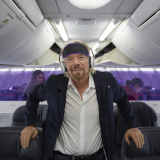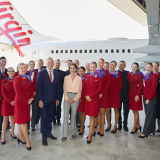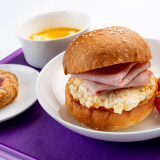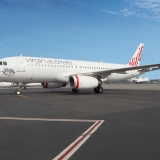Virgin Australia Holdings Limited (ASX:VAH) reports Financial Results for Full Year Ended 30 June 2014

Financial Summary
Underlying Loss1 before tax of $211.7 million in line with market expectations
Statutory Loss After Tax of $355.6 million
Group Yield2 increased by 1.2% in a difficult environment
Underlying CASK3 growth of 3.4%, incl. fuel and foreign exchange – strong benefits realised in second half FY14 with 2% CASK growth over the half, on lower capacity growth
Statutory loss after tax includes asset impairment of $56.9 million and restructuring costs4 of $117.3 million
Total cash position of $783.8 million, up from $580.5 million at 30 June 2013, unrestricted cash position of $541.0 million, up from $326.5 million at 30 June 2013, with Gross Debt reduced by approx. $200 million in second half FY14
Strategic Update
Velocity Frequent Flyer membership now 4.5 million, with FY14 representing the highest member acquisition in the program’s history and a material increase in member engagement
Interline and codeshare revenue increased 10.25% on FY13
Strong momentum in increasing share of Corporate and Government market segment – now represents more than 25% of domestic revenue, up from around 10% in FY10
Customer experience enhanced through completion of major lounge expansion works, launch of complimentary food on selected services and award-winning redesign of Virgin Australia website
Business efficiency project on track to deliver more than $400 million in cumulative productivity gains by end of FY15
Winner 2014 Best Airline Staff Service in the Australia/Pacific region6 for the fourth consecutive year
Winner of five awards for Velocity Frequent Flyer at the global 2014 Freddie Awards7, the highest achievement of any airline program
Virgin Australia Holdings Limited (Virgin Australia) (ASX: VAH) today reported a Statutory Loss after Tax of $355.6 million, including the impact of equity accounted investments. Financial performance for the 2014 Financial Year was impacted by the confluence of excess market capacity, weak consumer sentiment, continued economic uncertainty and the $51.6 million cost of the carbon tax.
Virgin Australia Chief Executive Officer John Borghetti said: “The 2014 Financial Year has seen one of the most difficult operating environments in the history of Australian aviation.
“While the Virgin Australia Group performed well in attracting high yielding passengers and containing cost growth over the full year, underlying revenue performance was impacted by the challenging operating conditions.
“Notwithstanding these conditions, it was important for the Virgin Australia Group to complete the Game Change Program strategy and strengthen our balance sheet in order to deliver sustainable returns for shareholders over the long-term.
“Over the 2014 Financial Year, the Group further increased revenue from the Corporate and Government market segment, which now represents over 25 per cent of our domestic revenue, far exceeding our original goal of 20 per cent.
“Furthermore, our success in integrating the Skywest8 business has enabled us to significantly grow revenue from the Charter segment, increasing comparative revenue by around 30 per cent on the 2013 Financial Year. We have also positioned our loyalty program Velocity Frequent Flyer as a significant value driver for the Group, with the highest annual membership acquisition in the program’s history and a significant increase in member engagement.
“The Group’s cost program delivered a significant reduction in cost growth over the second half of the 2014 Financial Year, with growth in Cost per Available Seat Kilometre (Underlying CASK)9 including fuel and foreign exchange halving to approximately 2 per cent – a strong performance given we had lower capacity growth and we continue to invest in product and service initiatives for our customers.
“As a result of several major balance sheet initiatives executed during the year, the Virgin Australia Group finished the year with a total cash position of $783.8 million and an unrestricted cash position of $541.0 million.
“Virgin Australia also re-entered the Australian domestic budget market through the acquisition of a 60 per cent interest in Tigerair Australia at the beginning of the 2014 Financial Year. Over the last 12 months Virgin Australia has worked with Tiger Airways Holdings Limited and Tigerair Australia to overhaul revenue and accounting systems, develop the management team, improve asset utilisation and enhance the operational platform. Tigerair Australia’s performance needs to be viewed in the context of overall industry performance and weak consumer sentiment, particularly in the last quarter of the year, which has a more pronounced impact on low cost carriers. As a result of progress made during the 2014 Financial Year, and in particular marked increases in customer satisfaction, Tigerair Australia is now well positioned to benefit from a recovery in the domestic market when conditions improve.
“While the 2014 Financial Year has been an extremely tough year for the industry, I am confident that the Virgin Australia Group is in a strong strategic position going forward.
“This next period for us is about maximising the Group’s potential, by extracting value from the business and generating sustainable profitability”, Mr Borghetti said.
Financial and Operating Performance
“Total Group Revenue increased 7.1 per cent to $4,306.6 million on the 2013 Financial Year, including the additional revenue associated with the acquisition of Skywest. While revenue growth in the leisure and regional segments was subdued, this was partially offset by revenue growth in the Corporate and Government, Charter and Interline and Codeshare segments.
“Group Yield increased by 1.2 per cent, driven by a change in customer mix and improved access to global distribution channels following the introduction of the SabreSonic system in January 2013.
“The recently acquired Skywest business has now been fully integrated into the Virgin Australia platform and we are seeing positive performance from the Charter business which has increased its comparative revenue contribution by 30 per cent this financial year.
“International revenue increased 2.6 per cent compared to the 2013 Financial Year against the backdrop of strong competition and a particular weakness in the South East Asian market.
“As we outlined in February, Virgin Australia increased its focus on driving down costs during the second half of the 2014 Financial Year. Over the half, we implemented a number of major cost reduction initiatives including programs to reduce overall employment and procurement costs, as well as introducing a new Fuel Management System, targeting 2 per cent fuel efficiency savings by the end of Financial Year 2015.
“While there was a material increase in overall costs this year due to the full year impact of the Skywest acquisition in April 2013, Underlying CASK growth was well contained over the year, with a particularly strong performance in the second half.
“Virgin Australia incurred $117.3 million of restructuring costs11 during the 2014 Financial Year as a result of the balance sheet initiatives undertaken, the completion of strategic investments and the optimisation of the business platform. The business has also taken a restructuring provision for the exit of the two original Airbus A330 aircraft, as part of our program to reduce our future cost base through further fleet optimisation, and has booked an asset impairment charge of $56.9 million, driven predominantly by excess capacity and competitive pressure in the South East Asian market.
“We continued to exceed business efficiency project targets, delivering cumulative efficiency gains of more than $191 million and remain on track to deliver cumulative productivity gains of more than $400 million over the three years to 30 June 2015.
“With Virgin Australia’s major shareholders equity accounting their investments in Virgin Australia from 1 July 2014, it was appropriate for Virgin Australia to align its accounting policies with those of its shareholders and other industry participants. Consequently, a revised maintenance policy in relation to leased aircraft has been adopted which required a restatement of prior financial year results in the Appendix 4E. As a result of the adoption of this maintenance policy, there is an increase in the opening retained earnings and the equity of the business of $67.2 million.
“Virgin Australia operates a very successful Australian dollar designated hedging program, providing a large degree of short term certainty and longer term participation and protection. The program achieved effective fuel and foreign exchange rates during the 2014 Financial Year, delivering a result that was significantly favourable compared to spot prices.
“In order to reduce the volatility of reported financial performance attributed to the hedging program, Virgin Australia will adopt AASB 9 – Financial Instruments early, from 1 July 2014. As a result of the early adoption of this accounting standard, future statutory financial results going forward are expected to reflect reduced accounting ineffectiveness and deferral of time value of options until maturity for qualifying hedges. In the 2014 Financial Year, time value of options has been separately identified from the underlying results in anticipation of adopting this standard. The 2013 comparatives have been restated in the Financial Year 2014 ASX presentation to reflect this treatment.
“Virgin Australia acquired a 60 per cent interest in Tigerair Australia on 8 July 2013, with our share of equity-accounted losses for the 2014 Financial Year amounting to $46.1 million. Despite the challenging operating conditions, Tigerair Australia carried 500,000 more passengers than the previous year, with passenger numbers increasing to 3.3 million for the 2014 Financial Year.
“In terms of capacity growth, Virgin Australia recorded normalised growth of 0.112 per cent across the domestic network (excluding Tigerair Australia) for the 2014 Financial Year.
“Importantly, during the 2014 Financial Year, domestic Revenue Load Factors expanded 1.8 percentage points to 76.9 per cent, supported by a record 17.3 million customers choosing to fly with us.
“Virgin Australia is focused on delivering on time services for all of our customers and we have achieved an On Time Performance (OTP) of 84.0 per cent for the 2014 Financial Year, an increase of 2.9 percentage points compared to the prior corresponding period”, Mr Borghetti said.
Cash Position
“Virgin Australia paid down approximately $200 million in Gross Debt during the second half of the 2014 Financial Year and finished the year with a total cash balance of $783.8 million and an unrestricted cash balance of $541.0 million, up $203.3 million and $214.5 million respectively on 30 June 2013.
“We have significantly enhanced our balance sheet and liquidity through initiatives such as the issue of Enhanced Equipment Notes in October 2013, the Entitlement Offer in November 2013 and the sale and lease back of our Brisbane based office in May 2014. The proposed transaction with Velocity Frequent Flyer announced today will see a further boost to the liquidity position of the Group.
“Virgin Australia remains focused on maintaining a strong unrestricted cash balance and continues to review ways to utilise resources more efficiently”, Mr Borghetti said.
Game Change Program Strategy Update
“When we introduced the Game Change Program, it was a long-term strategy to reshape the airline and establish the Virgin Australia Group as a long-term player in all key segments of the Australian aviation market.
“Over the 2014 Financial Year, the Group focused on fast-tracking the completion of the Game Change Program and finished the strategy ahead of schedule.
“I am pleased to report that we have now increased our percentage of domestic revenue from the Corporate and Government market segment to more than 25 per cent, far exceeding our original strategic goal of 20 per cent. This is an enormous credit to all of our team members, who have worked tirelessly to ensure we could attract this important market segment.
“As a result of the important alliances we have forged and the implementation of SabreSonic, we have developed a comprehensive global virtual network and accessed growth markets around the world. In just a few years, the business has grown from offering around 150 destinations to more than 460 destinations and increased interline and codeshare traffic by more than 300 per cent.
“At the same time we have completed the important process of integrating and aligning the airline operations and brands, delivering and investing in one strong Virgin Australia brand that is recognised around the world.
“Under the Game Change Program, Velocity Frequent Flyer has gone from strength to strength, expanding its global network to over 460 destinations and offering competitive earn and redemption rates and unique member rewards. Over the last four years, the program has doubled membership numbers to 4.5 million and has built the widest retail offering of any program in Australia. Velocity has achieved a range of industry accolades, including recognition in five categories at the 2014 Freddie Awards, the highest achievement of any airline program at these global awards.
“Completing the transformation of the in-flight and on-the-ground experience under the Game Change Program has been a key focus for the business during the 2014 Financial Year, with significant enhancements to our lounge network, in-flight entertainment and catering”, Mr Borghetti said.
Customer experience highlights during the 2014 Financial Year include:
- Completion of a major expansion to the Virgin Australia Sydney domestic lounge, including the opening of a second level with sweeping views across Botany Bay.
- Completion of a major expansion to the Virgin Australia Melbourne domestic lounge, doubling the size of the original lounge and featuring the Group’s first Wine Bar and Espresso Bar.
- Opening of Virgin Australia’s first lounge in Cairns and a second lounge in Perth, providing a dedicated space for regional and charter customers.
- Transition of our departures at Los Angeles Airport to the new state-of-the-art Tom Bradley International Terminal, including premium retail, dining and the world class Star Alliance lounge.
- Launch of complimentary snacks on all flights between Brisbane, Melbourne and Sydney and other selected routes.
- Completion of the roll out of wireless in-flight entertainment across the Boeing 737 fleet, offering seamless streaming to mobile devices, computers and tablets.
- Redesign of the Virgin Australia website, resulting in it being named Top Australian Website at the 2013 Digital Customer Experience Index Awards.
“All of this has been achieved while maintaining a cost advantage, with Virgin Australia’s Underlying CASK13 growth averaging 2.6 per cent over the last four years, despite the investment in major product and service transformation.
“Importantly, the Game Change Program strategy has seen us invest significantly in our team, attracting, developing and retaining the best talent. Virgin Australia has now been recognised as one of Australia’s top employer brands for four consecutive years at the Randstad Awards and our people and the service they provide remain our key differentiator.
“It is thanks to the tireless efforts of every one of our team members that we have successfully implemented this strategy ahead of schedule in a challenging environment. We have transformed the business and our research indicates that we have now established Virgin Australia as the airline of choice14. Therefore we can confidently say that “The Game” has changed.
“I would like to thank all of our team members for their passion and dedication in delivering the strategy”, Mr Borghetti said.
Virgin Vision 2017
“Now that we have completed the Game Change Program, this next period for us is about maximising the Group’s potential, by extracting value from the business and generating sustainable profitability. To do this, we need to increase the growing customer loyalty to the Virgin Australia Group. That is what will assure our business of a stable future revenue stream and enable us to deliver sustainable profitability as the market recovers.
“A few years ago, many travellers were wedded to our competitor because they had no other viable alternative. The Game Change Program essentially created an indifference15 and helped to dislodge those travellers loyal to the incumbent airline group, so that they were happy to travel with either of us, whilst building a Virgin Australia loyalty base.
“Going forward, we no longer want to create an indifference for this group, we want to convert more of them to our loyalty base. Therefore, our Virgin Vision to 2017 is to become Australia’s favourite airline group.
“Over the next three years, the Virgin Australia Group will focus on six key areas: capitalising on growth business opportunities, driving yield enhancement, implementing a new cost program, optimising the balance sheet, setting a new standard in customer experience and developing our people to their full potential”, Mr Borghetti said.
Capitalising on growth business opportunities
Velocity Frequent Flyer
“Velocity Frequent Flyer will be one of our key growth businesses, as we aim to build one of the world’s leading loyalty programs. Today’s announcement regarding a strategic transaction for Velocity Frequent Flyer is just the beginning. This transaction represents an opportunity to accelerate growth and value for Velocity and the Virgin Australia Group. Over the next three years we plan to grow membership to more than 7 million, further diversify Velocity’s partner mix, increase partner numbers and strengthen member engagement in both points earned and points redeemed.
Charter
“Charter also represents a significant opportunity for the Group to grow and diversify revenue. Our Charter business has had a very successful first year, delivering comparative revenue growth of around 30 per cent for the 2014 Financial Year, from a combination of new contracts, growth from existing clients and the launch of our first charter operations on the East Coast. This business continues to represent strong growth opportunities for the Group, and we expect it to deliver more than $200 million in revenue by 30 June 2017.
Freight
“In the 2015 Financial Year, we will launch a Freight division, which will leverage off our current Regular Passenger Transport and Charter capability. We expect the freight business to grow on a similar trajectory to our new charter business with revenue expected to treble to between $150 and $200 million over the next three years to 30 June 2017.
Tigerair Australia
“Our investment in Tigerair Austraia presents an important opportunity for the Group to participate in the growth of the budget market segment.
“The Tigerair business has undergone the first year of its transformation program, which sets out a clear path to profitability. The focus over the next three years will be on successfully executing this program, to achieve profitability in Financial Year 2017.
“This includes:
- Further improving customer satisfaction – Customer experience is a major driver of revenue growth and will be a strong focus for Tigerair Australia, with significant progress already made during the 2014 Financial Year.
- Driving incremental revenue growth – Tigerair Australia has implemented a number of revenue enhancing initiatives this year, including a new revenue management system. Further initiatives to help drive incremental revenue growth will be rolled out.
- Delivering cost synergies – Tigerair Australia will implement a range of network, operational and financial synergies, building on the cost savings from synergies already delivered, including the launch of the Brisbane base, coordinated pricing and joint procurement of fuel purchases with Virgin Australia.
- Develop an efficient operating platform and network footprint – Operational efficiency will be a continued focus. Tigerair has made a number of enhancements this year which will drive benefits, including launching a Brisbane base, securing a new more efficient maintenance provider in BAE systems and reaching agreement with Sydney Airport Corporation Limited about infrastructure constraints at Sydney Airport.
“We are committed to working with Tiger Airways Holdings Limited and Tigerair Australia to ensure the airline has the right network footprint, service standards and cost leadership, to deliver improved financial performance.
Drive yield enhancement
“In addition to capitalising on growth businesses, we will be focusing on other opportunities to drive yield enhancement. This includes increasing our target of Corporate and Government domestic revenue mix to around 30 per cent by 30 June 2017; increasing interline and codeshare revenue through strengthening and expansion of alliance partnerships and optimising our new PROS revenue management system to drive incremental revenue opportunities.
$1 billion cost program
“Importantly, cost will be a major focus over the next three years, building on the work of the Business Efficiency Project. Over the five years to 30 June 2017, the program will generate $1 billion in cumulative productivity gains and will centre on the following:
- Enhancing procurement – individually and with alliance partners.
- Improving productivity – including increased fuel efficiency, increased utilisation of the Boeing 737 fleet and the retirement of two 12 year old Airbus A330 aircraft; as well as bringing forward our Boeing 737 Max aircraft deliveries from 2019 to 2018.
- Streamlining our operations – including the integration of Virgin Australia’s New Zealand operations into the rest of our international business and the consolidation of our long-haul international bases from three into two.
Optimise the balance sheet
“Going forward, optimising the balance sheet will be central to maintaining a strong platform. The proposed transaction with Affinity Equity Partners and Velocity Frequent Flyer will improve the liquidity and gearing position of the Virgin Australia Group even further, providing additional flexibility and resilience as we execute on “Virgin Vision 2017”.
“As a result of this transaction, lease-adjusted balance sheet gearing will reduce by 8 per cent. The Group profit and loss impact from this transaction is expected to be neutral in the 2015 Financial Year. Over the next three years, we will continue to execute initiatives designed to improve liquidity, reduce debt and maintain a strong cash balance.
Set a new standard in customer experience
“The Virgin Australia Group will also maintain its strong focus on product and service and over the next three years, we will set a new standard in customer experience.
“While we cannot disclose all the initiatives for competitive reasons, they include: the introduction of Business Class on our Trans-Tasman and Fiji services from February 2015; the launch of our first Premium Exit at our Melbourne Airport lounge next month; the unveiling of a new state-of-the-art airport ground experience with the opening of our new terminal and lounge in Perth next year; and the upgrade of our Brisbane terminal and launch of our Darwin lounge in March next year.
“Furthermore, in the next few weeks, we will make a major announcement on our premium product offering.
Develop our people to their full potential
“Our people, and their willingness to go above and beyond for our customers and our shareholders, remains the Virgin Australia Group’s core differentiator in the market.
“We are committed to remaining the most attractive employer in the industry and, for that matter, one of the most desirable employers in Australia. It is our ability to attract, develop and retain the best talent, not just in the industry, but across Australia and beyond, that will see us succeed. Over the next three years, we will be rolling out a range of initiatives to continue to develop our people to their full potential.
“I would like to take this opportunity to thank all of our team members for their passion and dedication to delivering the Game Change Program strategy. We are privileged to have such a talented, devoted team and we are committed to supporting their development”, Mr Borghetti said.
Conclusion and Outlook
“The 2014 Financial Year was an extremely challenging year for the Virgin Australia Group and the Australian aviation industry as a whole.
“Given the uncertain economic environment we are unable to provide guidance for the 2015 Financial Year at this time and we will not be providing guidance on capacity growth going forward.
“However, the Virgin Vision to 2017 sets out a comprehensive plan of initiatives that will see us deliver a sustainable, profitable business over the long-term.
“While the current environment remains challenging, the Virgin Australia Group has significantly enhanced its strategic position over the last four years and is well placed to capitalise on market recovery”, Mr Borghetti said.
- Underlying loss is a non-statutory measure, defined on page 10.
- Group Yield is a non-statutory measure, defined on page 10.
- Underlying CASK is a non-statutory measure as defined on page 10.
- Restructuring costs (Business restructuring and other expenses) are a non-statutory measure and is defined on page 11.
- Interline and codeshare customers on Virgin Australia’s domestic and international network in FY14 compared to FY13
- 2014 Skytrax World Airline Awards – Best Airline Staff Service in the Australia/Pacific region.
- 2014 Annual Freddie Awards – Best Customer Service, Best Promotion, Best Elite Program, Best Redemption Ability and Program of the Year for the Middle East & Asia/Oceania region.
- Skywest Airlines Pte Ltd has been rebranded Virgin Australia Regional Airlines.
- Underlying CASK is a non-statutory measure as defined on page 10.
- Underlying CASK is a non-statutory measure as defined on page 10.
- Restructuring costs are a non-statutory measure and are defined on page 11.
- An adjustment has been made to H1 FY13 to normalise the impact of the Skywest acquisition. Accordingly the capacity growth differs to that in the operating statistics on page 11 which do not include this adjustment to H1 FY13.
- Underlying CASK is a non-statutory measure as defined on page 10.
- Source: Guest Satisfaction Tracker, July 2014. Participants were asked “How likely is it that you would fly with the following airlines for your next domestic flight?” – 65% nominated Virgin Australia, 59% nominated Qantas. Data has been collected and analysed by Colmar Brunton, a leading independent Australian market research agency.
- Source: Guest Satisfaction Tracker, July 2014. Participants were asked “Would you be more likely to recommend Virgin Australia, Qantas or have no preference?” – 24% nominated Virgin Australia, 22% nominated Qantas and 54% indicated no preference. Data has been collected and analysed by Colmar Brunton, a leading independent Australian research agency.






